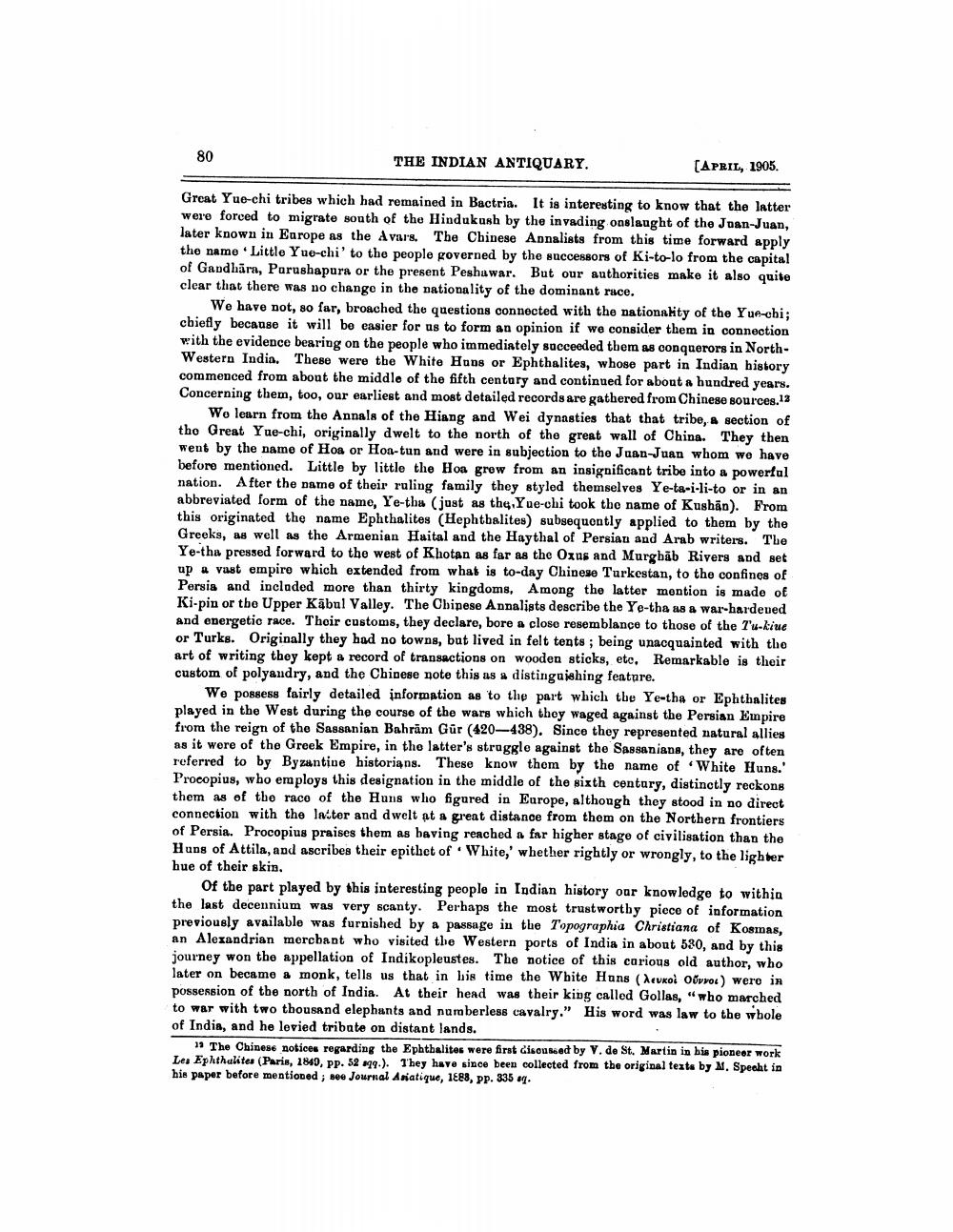________________
80
THE INDIAN ANTIQUARY.
(APRIL, 1905.
Great Yue-chi tribes which had remained in Bactria. It is interesting to know that the latter were forced to migrate south of the Hindukush by the invading onslaught of the Juan-Juan, later known in Europe as the Avar's. The Chinese Apnalists from this time forward apply the name Little Yuo-chi' to the people governed by the successors of Ki-to-lo from the capital of Gandhāra, Parushapura or the present Peshawar. But our authorities make it also quite clear that there was no change in the nationality of the dominant race.
We have not, so far, broached the questions connected with the nationality of the Yue-chi; chiefly because it will be easier for us to form an opinion if we consider them in connection with the evidence bearing on the people who immediately succeeded them as conquerors in NorthWestern India. These were the White Hans or Ephthalites, whose part in Indian history commenced from about the middle of the fifth century and continued for about a hundred years. Concerning them, too, our earliest and most detailed records are gathered from Chinese sources.12
Wo learn from the Annals of the Hiang and Wei dynasties that that tribe, a section of the Great Yue-chi, originally dwelt to the north of the great wall of China. They then went by the name of Hoa or Hoa-tun and were in subjection to the Juan-Juan whom we have before mentioned. Little by little the Hoa grow from an insignificant tribe into a powerful nation. After the name of their ruling family they styled themselves Ye-ta-i-li-to or in an abbreviated form of the name, Ye-tha (just as the. Yue-chi took the name of Kushän). From this originated the name Ephthalites (Hephtbalites) subsequently applied to them by the Greeks, as well as the Armenian Haital and the Haythal of Persian and Arab writers. The Ye-tha pressed forward to the west of Khotan as far as the Oxus and Murgbab Rivers and set up a vast empire which extended from what is to-day Chinese Turkestan, to the confines of Persis and included more than thirty kingdoms. Among the latter mention is made of Ki-pin or the Upper Kābul Valley. The Chinese Annalists describe the Ye-tha as a war-hardeved and energetic race. Their customs, they declare, bore a close resemblance to those of the l'u-kiue or Turks. Originally they had no towns, but lived in felt tents ; being unacquainted with the art of writing thoy kept a record of transactions on wooden sticks, eto, Remarkable is their custom of polyandry, and the Chinese note this as a distinguishing feature.
We possess fairly detailed information as to the part which the Ye-tha or Ephthalites played in the West during the course of the wars which they waged against the Persian Empire from the reign of the Sassanian Bahram Gür (420-438). Since they represented natural allies as it were of the Greek Empire, in the latter's struggle against the Sassaniana, they are often referred to by Byzantine historians. These know them by the name of White Huns. Procopius, who employs this designation in the middle of the sixth centary, distinctly reckons them as of the race of the Huns who figured in Europe, although they stood in no direct connection with the lacter and dwelt at a great distance from them on the Northern frontiers of Persia. Procopius praises them as having reached a far higher stage of civilisation than the Hung of Attila, and ascribes their epithet of White,' whether rightly or wrongly, to the lighter hue of their skin.
Of the part played by this interesting people in Indian history our knowledge to within the last decennium was very scanty. Perhaps the most trustworthy piece of information previously available was furnished by a passage in the Topographia Christiana of Kosmas, an Alexandrian mercbant who visited the Western ports of India in about 530, and by this journey won the appellation of Indikopleustes. The notice of this carious old author, who later on became a monk, tells us that in his time the White Hans (Levko Oővrou were in possession of the north of India. At their head was their king called Gollas, "who marched to war with two thousand elephants and naraberless cavalry." His word was law to the whole of India, and he levied tribate on distant lands.
* The Chinese notices regarding the Ephthalites were first discussed by V. de St. Martin in bis pioneer work Les Ephthalites (Paris, 1840, pp. 52 99.). They have since been collected from the original texts by M. Specht in his paper before mentioned; see Journal Asiatique, 1888, PP. 335 .




